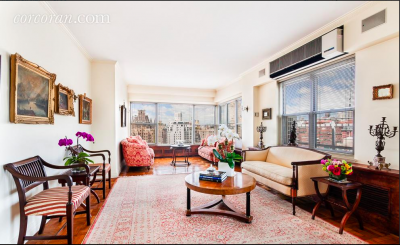New York real estate’s brisk growth is beginning to taper off, with the first-quarter marking the lowest annual growth in more than three years, according to a new report from StreetEasy.
The Q1 2016 StreetEasy Market Report found nevertheless that the median price for real estate in New York’s Manhattan borough increased 3.8 percent to $978,765, a healthy growth rate by any other standard. Economic unease is slowing a recently booming market, but New York's investment prospects still look better than other markets in the nation, particularly in the longer-term.
"The Manhattan market is highly influenced by what happens global markets," said Alan Lightfeldt, data scientest at StreetEasy. "Manhattan is seen as a safe real estate investment, so when there is heightened volatility in other markets, we typically see demand for New York luxury properties increase. Recent turmoil in China's stock market, for example, caused an increase in Chinese demand for US-properties.”
Adjusting expectations
The 3.8 percent growth in the past 12 months is the lowest the borough has recorded since September 2012. Across the East River, Brooklyn saw 7.1 percent growth, a sizable increase that nevertheless represents the third straight decrease.
A number of macroeconomic trends are likely slowing the market. The U.S. dollar has remained strong against the yuan and British pound and the price of oil was at an historic low during the same January-March period, all of which likely deterred foreign investors.

174 East 74th St, on sale via StreetEasy
StreetEasy also highlights more disciplined pricing strategies from sellers in both Manhattan and Brooklyn. With the market slowing, sellers no longer priced in accordance with the excesses recently common in the market. As a result, offers were closer to asking prices and price cuts were smaller and less common.
Only 27.6 percent of Manhattan listings during the period had a price cut, a decrease from 31.2 percent during the same period in 2015. Overall, sellers received slightly closer to the asking price, at 98.5 percent, than last year, and price cuts averaged 6.7 percent rather than 6.9 percent.
While the overall market may have tempered, particular pockets of New York continue to boom. Upper Manhattan surged 9.7 percent, with the Upper West Side following at 5.7 percent. By contrast, Downtown, the Upper East Side and Midtown had rates below the average.

1001 Park Ave; co-op for sale via StreetEasy
East Brooklyn, South Brooklyn and Prospect Park boomed, but the forecast is less thrilling: Overall growth in 2016 is expected to contract to just 1.7 percent, far short of the expectations set by the first quarter. Manhattan will also continue to slow, albeit more languidly, checking in at 2.7 percent on the year per StreetEasy’s forecast.
Slow but safe
New York’s desirability has recently alleviated it from the damage of larger trends, but real estate throughout the U.S. is also faltering.
The luxury housing market is in a slump, with prices falling 1.1 percent in the first quarter of 2016 compared to the year-ago period, according to a recent report from Redfin.
Aside from a positive blip in 2015’s fourth quarter, the market has been slowing since the third quarter of 2014, so the drop is not terribly surprising. With prices falling, buyers are taking advantage, and several cities are proving themselves as viable luxury hubs for the future (see story).
Even as real estate battles through a tough time, history shows that its value as a long-term investment is hard to match.
Despite stock market volatility, geopolitical instability and new regulations, prime residential real estate still has a good outlook, according to panelists speaking at a presentation of Douglas Elliman and Knight Frank’s The Wealth Report 2016.
Oil prices have plummeted, governments and the IMF are tracking the flow and origin of incoming money and many assets have had negligible appreciation in the past year. Nevertheless, a look at recent history and wealth projections shows that a bet on long-term growth and on real estate, as well as classic cars, is a safe one (see story).
"There is no sign that the Manhattan market will accelerate before it falls," Mr. Lightfeldt said. "Just the opposite is occurring.
"As markets wax and wane, price appreciation typically slows to zero before dipping into negative territory," he said. "We've observed this in Manhattan over the last two years in which annual growth has declined, and we forecast that it will be even lower by the end of 2016.”
{"ct":"FVAO1qByiOKIDP5p3ySrru9r29261n+AtRtS8kNzrW28OAqZ1na3kqD94M6E73igPC3cmF5\/sB\/u3p1cLF9jaFedzcETE1kagBujZEgg4XeTrCBjLPI\/5HcO7elba3evMj06FnVOsi5LJhbyYb8WwCid1KcoATHczzDkwR+9RUXgVtGuCAqT7iixWpZbSy02RfIqYLtxIhgIabkM5lkEoB7Ba3McUctpHHKELX5xxmjHAYRYGVIq7u4hn6KoQADJOq9FC6oSBJNuy9C\/6bSbdBUAXpAzEc9gMzjRYBDDQ4xWdSoWu3RQDJwSc5AwesOf99N4Dc7yZvAH60xDC+4r15LjI1S0Zzu8+BCHJz13qViKM+Ukl\/yrTifKxJYPBIODE17iLsq5vyPMDved33x2C+Bb09cDy\/crTmfQZ+T1HTkJE77fopQwP+zALbL1ZJ1GHmZqNqirSykIev6y5\/yBqHsGCGdQdvPdN168mUca4sjXZNVW4cmVnSCFLlD2SEIxL0ZEFUwDaPiHx2TMplU6Uy5J4iRjYoqHjGtbgL4l3Fp1s8LASq2zT5t4ZnMwX7UjZRTYmjrFD4xGN\/UhtKuYtrqOvKQI7D8n4e5lgzlGaGT1EOk6XJ7wym2opS5AFVQ2OQgwtvPprFNlwy0qqQk6o4Z2ZvTaYA6GOyH6OrSxy4D1OJPx01zddhtQtqwH\/eNYhbcye91UQbmO+hSYdItFqSshrFysbtuMP+TsQQfV\/4ARdSeAoyJWArz5IAanxTlT+o6qIGxk2s0c610M7mqv8rcvhy\/r0CJ+qfLIrfuhZcgeMkttdCV658SILRB4fV707V6pSdjC5h\/vakSp+XlRH9xNqbEczp33rmUjbUmX6Is6QwYaAoWrcfvxFS9peFVsnYr1h6a9iKTZDK+pMOMAUTKUbZl6LpzvIPSydT3hCec9ngJ\/lf2hHCa8imz4z\/A+wiTV9P0vjcZyCjr3RtYjpFh23+S6ugYf5KB64zoqjFHEZAJ+AQl3EGhxNNOJRvUm4PCfOSosOZS3srm3UC6nqU2yIa6TKu8fiLbyvQmglhwo8YfD5BpX3ht1iTpK\/zJZpDojg0Q1MOemsw4Eu\/Py5EUordqGCAgPPjvZM+UchNz1yFfFtDhHh83fYMxWQypki0G9y0K5u028yb7I6tClviZE5JYKkFMr6woff2J2B8YPQMv50HVQCgOEW6dD8AJElSwRq73ocDb7xwQE99hWuq9eWrgwLqynp+pN65PQwRUnYlmT5QAyOrxkTotcXz8e45pCWY\/VG3oHtNJJ4+SwwVliRUY1eQVPuGjt1d4YCmh\/Ynn\/tbwONC9WxSOd\/widlqcSBLFmHuXQ1OoBHVpO+\/6spuF\/nJXjrU5FuRzp1+R9VJzLP1LhFxRzy4oRJzE\/gRDmlrsDTxXMyeXcPIrOeopjalfswjrBejJG9yfW6FxlcKcZgkTNHQq6fnXAQorDtPheTgJ03MmvAX8N77AbYEE+h8awR5DVP8FLXnBOriTFSi2wNFlmkdoDUQGW0sVZQCDNLL5nYY3\/aAEfhwKMmK2iEwuQo7PDEyBupF6wQSS0Mhb026bqKw21PVS6Z7M5adwD9FS\/\/h19ITnXvo1r2ba7aYANJ56NAa69OFTJv0lJgttiobHZmtEhDSaEXsbJ1cr1f2gI20Y+IqpngxR15oa3II+vlYOu8oz+h\/UCYtYQTJgSAHUo7kuR8He7MTAoFt2D+abG8d2Q1g+Me5yp+Sz0uoogFMiTtXBMw\/ZPkR++1LQgsK8\/rbY4KGs4izBSwg685AQ4t6ulbqS5sl+8sTtxjsbtRLUb9OomDEmDCVdTGdgO4Tbuj70hkbFoaRYQVwf09Ip3u++EPElpguOfvb5i9dG0NgfBH0fqA9gDPGPJHo4Cctlq\/Psx8lgl\/+d+2pbiE2uYYGl698VoTmZiDEaq9bOVuW7I\/2UljFdDhgAGGPZgy0tIy+AtQX9xTjkA03k+ClF2PptVC0tvBfz4zyOU4WPv0XgfmrwLqcIqtmg8Q62Mc\/EyYm1lRCqXbJlovZFFz3wZI5v3jeJbY9La3Jip4LziEVQ\/S76a1VcWU24tlTCoP4BadFp13vhs6IKgLC+uXOjmKnPWjvVmRuYuml67SX02tftC7j6XdkcIFp6td6+qz71yYEVNSd7AInM9bxY57JLYa8tvFKuaRSRbzXV2LRRWomra2xTo+SFE8JCLtfNjzWFp5fMG9ni2+S5dK\/5EcNIK0sqkrr8Klr8+5aUZEy+xGwd4uIzvwE34y\/q1nK4HIBiimZMoen7fzpVD9LadIl2vQIUIyRJPhusxFtPhDnG6t9UD2EbskCnBp5HEYw9W\/VwEvDfXdm8Sj\/sLOZWpDfdNQvDmoq6ucehCx4nJEJF54edsXEMy8GdDCU\/YcxXGuBVtISWLII7vcMHHFj3fquh2bpYSgmsGpt430YitbrfnlJBSF3qXkITtABSFsVZLiTaBvwfN+Q+q8dw7bEGoSkJ7SKLdtk8GbfqBWSKnzezyQLU1ygQkMh8fxss1qjFL\/0c49CmTDdjUhfqVHKBnKhLBqNeI6JEDRFShPaJ+9r3txhZHXGYwziu1UGA10L8DXJDeqzA4+rcyCOhivAliHBvRhro99DhoWARGyi6HxtxXP6wH0LcHetwE1HIK\/92wgbP9pr13F7+WhLicvTuIgjag4JR58di+EgtSH90UgbjoIpRugyXr18yBh0QF2udDO3mw4fihlq6MB1gkkuqJ0kSGt0me7jxqORLeqrVdzDqN02qFoPZ\/2cPv4IWMI6CNnmlanvTJFW+OMKP5CLhWvniEgQEF7tpU5I4DL2g9jftSkvWFZqve1ADPRTFlBbmWvAfxitKBhIsX1r6iXzlh\/6DtnKxqhwlvbixRu443EsnPkEzRqjoyevVN6OxNWFevYLsPAh4fWaC\/+Oh1uOmeHqFsAtDgArRInP7WFqcsqSWEkhNFbwFWyf8OM2QFco3eNMAM7j4+kpxffA+4L+WtwQWPSsGmMzFNTajFOHRwBXlUC\/PvLUg2nt3dM+DsFC+ihv1m48H\/NI4Z9HByXUMHMi9+NrbwtjBifRPC1smqlOhYFXPlPIZvEwKYm71gI+amp9oEBUZGHU+5IRwQTSB9izjFSr4JZqPtieDE9QLYHcJJgYiMGGZw8vQj22VnRLv2I+6Kw6SuasxiUquaR8A2A8kAGxYEpqQTaJWi6hAg9efGJByTXurDTr3\/BSHPqy99F2+Z8TqLYw9H0K4D+xsIqXQB5+A+HI3+qIYJKCvxoxdL+0jO9Pv0dCJ8GLbZTIVVf83grLUhomOp3QKU55D58Af7s\/IoMS7ZxAa20RcN09tzPrjpmK\/L\/SRIzWeNtlbYfw8HDAEmXvOp2ZMtnLZ7CS6Xr46QdST6DIzO7cyQiQj2xgbMx2m3jDtHnR6AK4aggTsKFnlZChLjH9bEOfo+lyvnict2\/hCUUT90DFotjiDj7ANUXzG0HGtkNPIJwsfsMQBlrn3SMdqio4T87iXOYo9LpT6yZMffcHEe5UpCF6TnGKkAHZ1ARYwMSm+tQjz1rhGxr8fyk4xAb3US\/0wP2cZWZKhb9FYG80\/UGJU5jSTRh5KR+oOqZKm5CLZAbkkdBO1ILsLVsiv9YNURL00Fawj81ZSwyQmx1PHOvHYZOitLuDNAaR9hpy2KA6qpbJsPe+PzpnmEZX2tkcmoQieV69Mpr5uxlpxfFlmZUJXeadqUS3tRFvzRcozM6KLSoSYYHsPczCZ7hr501qIvWBxc48WrGPH00S+7kJA9F8Vo0V73F1MIvdiQk92SZXjJTYwlR2Cn214UBanQ8ILAu2d9+1dRgXlLP0I3H49t1p9NIN7dU4omedWs22TzGRWQhhyvHKZsZ1KeVEwHnJ9tl\/0As0HFwj+lps\/qNg1EAZfaW1C00SMx+\/gHIbW9db3zwzmfWdhCDK6U9d6e6bTWF9ddwNkcT9xJ6UxupEjRBfPIkpzpgLfstM\/JQyDUm8Mtp3Xa+3ElPgpSmUJDiF90h1rFYsQsMuKkGx8IJT9Z5uGzNrBXXJIdLUB7h4fyqr+6tPTfVk8wnnQhBj7OTcUvmDFfKun36waaISHpy6nbu0qpLAdMwIbk3RRhmfyZ1eGnxZvnEVb\/UroCxO8kZ3+1Z3w6PWSthNWihyZ9DaeNS9gJTXFeQ8de103drlOjUpUK4SNRU7hvYdau5wAes6NY36+J4s1KKW1TqOObgDM5wmDSrFc8SbZBSfXZbvvI\/XhDEwGZoPMxbyxKooKvg+b3VsI88gN9vUU7Kv4gB2tB+iaoTWJLI13cXJqx1wOdD8LUFB+wM+uTufJ8E9IBsELwasPLdNblErXw6xHVQC3MjFsEuLK20kTjXpp3HMrMWVcpTNhEV+\/T+TvF3JxaTmSziMwO8Aua5HsqlaxszityysSRNpq5StN9Fnk4jDbnwWWJCMyhaXKxkkahzr3hjMIqWnuQ6SeKbQkq0mJNossaObdHvkLrrZQaFFH6a17j3SxYQcLVZlle1t0iNhK5AdK2Fpw4s75Wtl3eNwDuFFXqorGrfNOs4X8mKZKjBJlyyeIVWjAx2iagQwobW8TTIy6+ZtX6cEqtf4+wF8wp\/ad60r66nUS52kGvO4lC\/+8lMISBnh5mWMYK2EMQqs1TF1YsiUbvDbT5+SGuXSfHxD\/kyKSEUyAzTkSZNHZ3y9gTFGAgwEDXb3QJqkoWymGVlsdq6FFndJKg9mClGKc8s1p\/d6ahgPuncTueDwUsWbrL7yyZaW0xF37mjCNSpntSWRysSdR7hlCEkCF6myV6C\/zcSN3mg2Vsq3ueZinbDceKhrtr\/oIn0rMK1DujXN7Z3BdbME461Q2j6AsdnkwFxbbZyl4D4gHeQ0stKlOlFxcEBwtpdjLVkVbvsdKuuBTegGB3M1SpzyAG64A1UkcvldXiz+MqkEXjznlb86qYd0fChsO8bCvUPRQDQpq959W1vhtLRZamaj1oSb7nOI6dJRp9k4AC+PAIJYeiKhn1urYGmRgb7XC\/OIzTPyUpEkz5s681khBCKXSGYgvCTcquRmni+N19DiNexSfdqHt2BSfS2aTh1dl\/UioXsIoDJge3tW8TZe4BIEd3o0wNRi7hR77fyOkbGnsWrdC8iTfu2XjxIwFbb4pOXK8lsSDFtOei3mwaji0GLAUnIp0hs4EnE+8+7CSjnyq\/oK+QJ7c7Zcq+y2BEY32azqb4cYHb5rpGWmuGfZrKCqbH93shBsVuEs8miRrCD7VzeXe\/1rSlKj0VAVQW9QdhK6mylle7IRp4gXgvYleVRvNFaTq550ybbMrp+cREv4at0XBEiRsBYarvFufB9qmpDTOxaUrVtcBztlx8DvcsGooguMdMUDVRm0F6rtmFJ7yqvPh3J7jBjJED9N7XYKU8gASPFvWqPTdiq2RsXXuVTay1fSaqFrnInu5DNnEiXwMfBRrtFzVPxkpIOsN8LejafaXPEzRMDTEeQMiMlLxWqyT1oMaGjxyeEGP7mB2ZWMK7C5X5ANLNmA74uStS2rnW1n5x8QjQtFazkMxIjONDZPw936dZgSeESOGMJIAozQJBVsF2J5RWWAsICgsnKoZ\/QzftG\/MYXBeUL+COXqXduJKkFktnYKGCYA9tWcnIpOHrGxc04RKpmoSG+hqS\/rkWcW+FXySxdxXZiPiyiRwZ3zpWyO58vnMChymeJ\/W1HagzAEvgZ7aJJCp62Ax4ATI342K0C3mhP\/fZnS2xHDV1fC+ViGXFzgZkBN7SrPDXpaU178LIJuTwDbOEZBa1CKODC10NgD19E0Ky2UDxzQ9JdxtJsAFvc2Es651FGfceRfC89o+m6mLaX+0\/E8Hn3kNi7dCXESumggIymIAcod9XZocrvlN\/6kaoe2Q72Hg0dXdxaW51XVU4kbz0\/zFxqvxWberTTNIEEsqLO6h4YE2QhQlxrDvwc8DUtiInyVEflcyyK6Y0xdB35BWJEcPyqGbr2ViKB536KA0dMf3ANBom51SDmnqg2im2Eb1q9tNCuQ2OrhuWg6fD9l4U3CLEtd4B8HGzgwpaxH9xA\/x4USW6ERacO62UsTtSe0B1oJPlywW3PhlB6wWaMydGtmrQd+5rLyMw9HPghqHZXbLOTBXBbHwI17PhLNxJU0Jm3YRFFz4Wq3eFHEtfMzPP55WmLjtyF86MIQPngpp1wV8ioTeyd0NNabiCGNbYTqxyHMpwNnwcR6oiv8zR60YGwitVW\/a3xMrldfM28U7u5XE4Q4YB1Cvo5ZvuvqkpsG+dbzhR8Mc1OlY493pHeWNrQY7juXnwancmGOPOZxEij3B8wEQkeGJbtbJvlbsfusI5vB14uWOgihOHgx3Oi7VdHRe\/D8tE4AAX0U2OjiB4Fkez3\/UIk0mRHqWTPXKmidqUM2ZboirIaMImdmpadQ6ullf+74grr85vw7RST3Ld+tVD\/XNYyW8cUXrwgQB+yMZdPHK1Xm0DVhWUaSDfkSYpTkRb9Y2WCEIfD3jUMY0nOlVL257AjBxxxPjroVrsl7SwIlardzuL180lXZrsuK+Xn5EQKrUm3C5N\/4At4F6ydm9kgHZFKsNWjaEvpsMajN0qE+bmEOEQ1yFuxNsTlszYsL16+U3BKA38ErsBpvXLH5kJ1BFbUqumWHvTk4LKhyWp8ljwW0VBhPEUg1Hzs764qF55\/NcZtSOJ438+P6hC8gQfAP\/md7mljhn\/hBcT01cRdLSBlPuszdPl6idq1rLeEr8HY22UGFDMl9bXoK0e3Xx\/LdM9tPbNBOL61vfw8PdBRRnkgYpQg8qXzB2RZPViE47gJ9WMwNUvzjM4xWi85J7HLRTV9lwVoRp8Tl8sIO7bY7PprsGbMiRma5gENxTBr+8g81XbDJvWzCJbiJcZitJBs8a0lFzfsuItANpapdqajrSISWP9SzN5yoTT3w5FP+60oz82JPiUy+W8vwn6WLd1SbvYrdfaF60pdietdS3lPNB8WJjv9Omtn3XtQdUMTl8jTITrKVR3gcgAZj2Id26ET0fw3kO5ar9wDLMw\/m+Q7XIR42yNKyqIylW3hVoMkw47i4IXeJztJtyiCWnjC67vX75toK+MyZ\/45zIqeUVYWMM84BDf750jXDO\/+N+URVxu0cH+2hk0byH4GOeSJvOufaRALU8HkV8RMtCTeeLCR7reGrFOwBSTVMb30KS54tBguKBMDNiO3sKnBjgM4SIG+\/bXICPkYBinc203VCSxsFr7SpwuwXSkVEFC2SYOL8XlO2fZwA42f36aro0NbTbxUtjJhabab8iRnenTbKJ3bxOrfqMa2mBxLmxin4HlTTuWnCiY8979MFlkOGb2ptBnOKg1YqtwuKbL1JOyPNnV72LGCtIGnY5eO84z1YRZmWKc+1hEX9ZAypBRf94pfmWjVqiSovhUEgDmA\/VUYLYRlS7aMs6yzyv8khwwYgcx704NG7e65UExrNB9rN1174HZtqSmbWF\/\/PtJrTFKJgCspDRObrR2fkKaWVVvsEBSTfUW9b2uOiyw2AHiOe3Rvd7Y\/d7przj3t0tilWjFMawBLr6OclPhlu+GUeANiWEjEubf9o2bJ3o56nx9dWNF2FIBSUV5\/Y8ym7Qs7GgZ7DMbx9GiTq4rgMr6J5Uvg2gfodtw3yleSzW\/r0EjTcl\/OT9pWUK4WD1wa5mc0F2da9SFVJT697Z+z0NSdgkLDL0dTUqsZ+P3mG9ESpRBnXa73Y5VSDkLahdEBnb5WCraSnUB0R0+Zto8xrzRSYap5cVM4DBuM41ftFwUiGLqLGw\/TbFw3ilVC9z0IbsJ1307W0GE+4vi9j9lu6cCZ3lyHns1Sg0B2\/rxAgolFG6ZTdtzfG0JHqR8P08ibL70oXcYq6GzA97pWUXcXZ8QpZjt8WLEl0kM7JEnY1cSzC9wHdHhlJ4Au21m791\/kPUDwSQM2BO6jQtRkahm+U\/Ty6xdH+pddcKQhW7ivm1ZOnHo6YFv8AcNqFcVzfNwgjDYEdxQ2ndQxyWmtUGHK4iXhETCf94DG0wavDYzmFlgWy5oFNWcC+uCJfC1qtVdykHRPs70Mjo7sRWowSlHByYWO4BxlTKzK3lj8OBX58zynU3ZP\/QQxNTUsuklhZX7UYKqenc\/x2UdchNNoFax2VeUiN3lToosa9xQjsJvSEfaWSvReVhD8CgQK6iD0kAd4XsQLrctcf7y6ZhoVQTPDCJ362mdkiyeCr+y2gnopSP0lleNZ5LzOyrX+VFdxbRhIMxielckR1nCoWnpndsn4GLpS4LCs7iDyAk=","iv":"4a6388cceba9dbe9b9ff4b6daf7bb61c","s":"5768a8ec284e2e19"}
